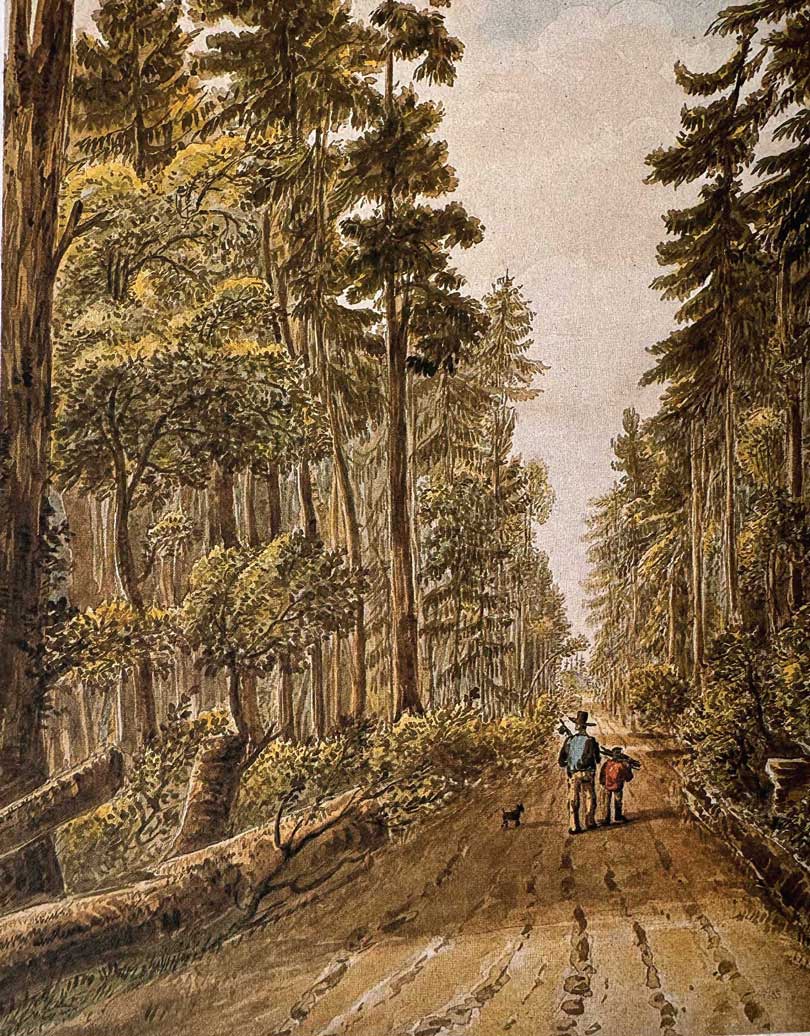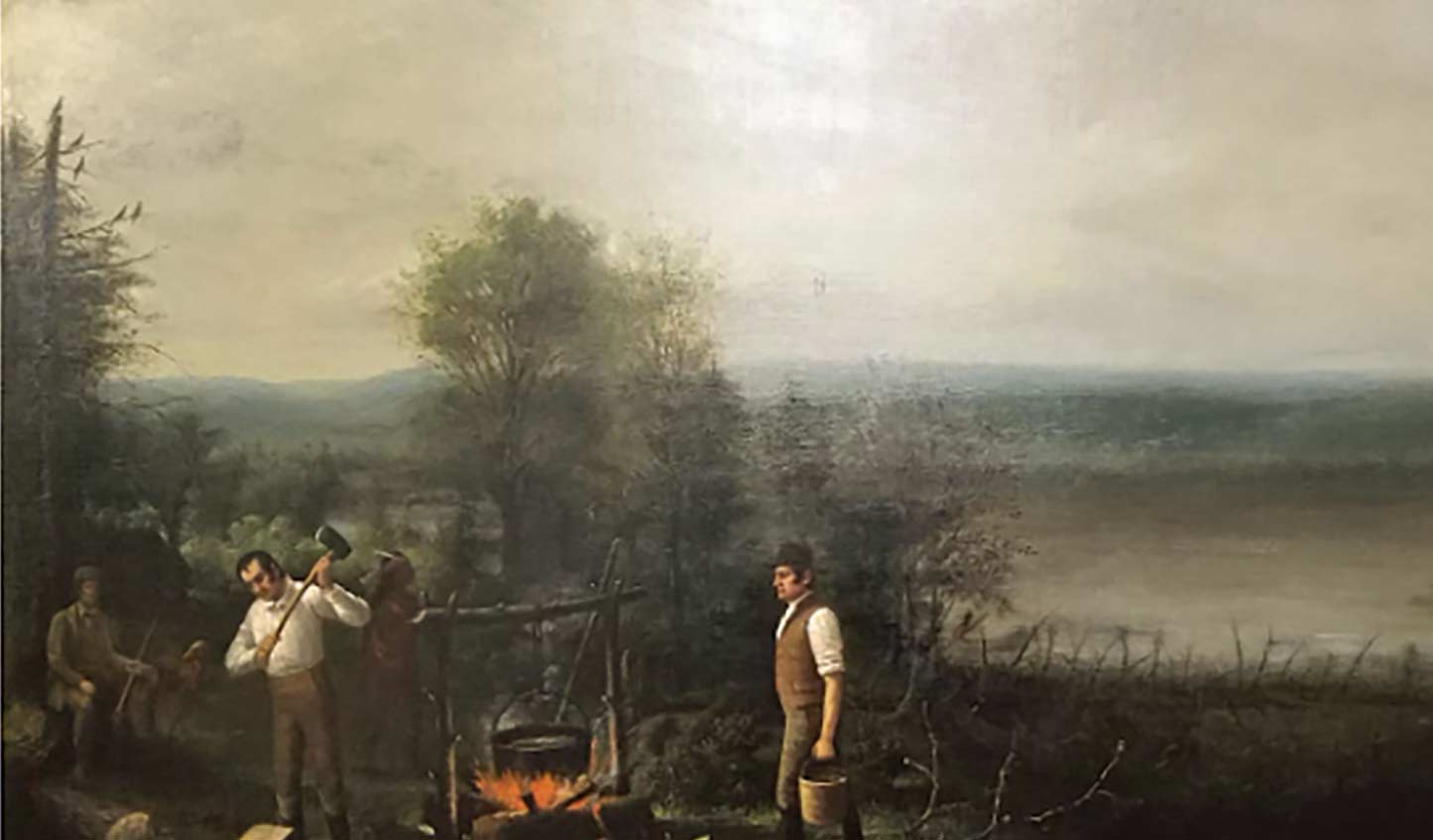

left to right: Clearing the original Danforth Road; early photograph of the halfway house built circa 1810 on Danforth Road in Hamilton Township; illustration of the same building by Jack Beech.

Asa Danforth’s father was one of the first settlers in Onondaga County in Upstate New York. Rather than farming, the family made their living extracting salt. It was in the salt pits where Asa Danforth honed his entrepreneurial skills. Image courtesy of the Onondaga Historical Association.
There’s a story behind the Danforth Road, a tale of a shady contractor who had a rocky relationship with the colonial government that hired him. When it was all over, Asa Danforth wished he’d never set foot in Upper Canada.
Just before he left Upper Canada for good in 1802, a disgruntled contractor named Asa Danforth sent word to other Americans who had dealings with the British colony. Seething over outstanding payment for work he had done to build a new road through the fledgling province, he wanted to convene a meeting in Albany, New York, for the sole purpose of summoning an army and launching an invasion to overthrow the colonial government in York (now Toronto). For Danforth, the unpaid bill was the last straw in his litany of grudges against the government. He was that angry.
OUT OF THE WILDERNESS
If the name Danforth rings a bell, it’s because the road he built still bears his name, at least here and there. If you know the County, you know that Danforth Road defies the grid survey and runs cross-country from Hillier to Wellington. Similarly, there’s a Danforth Road north of Cobourg that takes a diagonal course on its way to Grafton. And of course, there’s Danforth Road – and Danforth Avenue leading to it – in the east end of Toronto, which like the others departs from the standard grid as it runs parallel to, but distant from the Lake Ontario shoreline.
Except for keen historians, few realize that all three are related by more than just their name. In fact, they are part of the same road, which was blazed through the virgin forest at the end of the 18th century and named for Asa Danforth. The 250-kilometre route from Toronto to Kingston was the first continuous road along the north shore of Lake Ontario. In its day, it was a key piece of infrastructure in the government’s plan to link the distant settlements of the brand new province.
A road through the wilderness was the last thing on Asa Danforth’s mind when he first became aware of opportunities in Upper Canada. Since the end of the American Revolution, he had been one of several entrepreneurs engaged in the burgeoning salt business that was the lifeblood of early Syracuse, New York. In 1792, he took notice of a scheme launched by the colonial government in Upper Canada, which proposed to pay contractors handsomely for recruiting settlers to the newly surveyed townships on the north shore of Lake Ontario. Danforth’s interest was piqued, but just how “handsomely” he was to be paid would prove to be a matter of argument and would lead to his first beef with the colonial government.
A TRICKLE OF SETTLERS IN A VAST LAND
Upper Canada, which eventually became Ontario, had been constituted in 1791, but was off to a slow start. Refugees from the losing side of the American Revolution had already re-established themselves here on British soil, and although it was the largest mass migration of people in the history of European settlement in North America, there weren’t enough Loyalists to fill the new province. Immigration had slowed to a trickle, and vast sections of the colony remained unpopulated. Lieutenant Governor John Graves Simcoe knew that settlement was key to securing the British claim to lands north of the Great Lakes, and sought to kickstart things. In his bold plan, he entrusted entire townships to the exclusive control of contractors he called “proprietors” or “nominees,” who were charged with actively resettling American farmers in the Upper Canadian wilderness. In return, the proprietors would be rewarded with large grants of land.
Back in the salt pits of Syracuse, Asa Danforth was definitely interested.
FRIEND OR FOE?
Perhaps it sounds peculiar that Simcoe would look to the United States for settlers, considering that the Loyalists had been expelled hardly a decade earlier. Nevertheless, he surmised there were plenty of colonists eager to remain under British rule; but more to the point, he favoured American settlers because unlike immigrants from Britain, they had homesteading experience and knew the rigours of a northern winter. What is particularly strange, however, is the choice of Asa Danforth as a proprietor, for he wasn’t known for his Loyalist leanings. Even Simcoe had doubts about his allegiance, noting Danforth’s father, one of the first and most successful pioneers in the Syracuse area, was “the most virulent enemy of Great Britain in that Country.”
Some of Simcoe’s proprietors met with reasonable success. We only have to look to Port Hope, where American traders and partners Elias Smith and Jonathan Walton were instrumental in building a mill on the Ganaraska River and bringing the first settlers to Hope Township. However, Danforth’s efforts as a proprietor – and those of several others – were a disaster, and Simcoe and his successors only made matters worse.
The bad blood began with confusion over just how much land the proprietors were entitled to. Danforth and others claimed they were owed an outright grant to their entire townships if they succeeded in recruiting a certain number of settlers – but in fact their remuneration was only to be 1,200 acres. Disappointed with the lack of progress, Simcoe cancelled the scheme in 1796 and forfeited many of the proprietors’ land grants in the townships for lack of settlement.
Asa Danforth fought back, claiming to have settled more than 200 families in Cramahe, Haldimand, Percy and Hamilton townships. The government scoffed, demanded proof and further infuriated Danforth by telling him he would only be eligible for his 1,200 acres if he actually resided in Upper Canada. Danforth and his associates took the matter to court, but his troubles were made worse when two settlers complained that he had falsely entered his own name when registering title to their land. The Crown charged Danforth with fraud and duplicity.
In the midst of this legal quagmire, the story takes an unexpected turn.
Elias Smith and Jonathan Walton were instrumental in building a mill on the Ganaraska River and bringing the first settlers to Hope Township. However, Danforth’s efforts as a proprietor were a disaster.
BLAZING A TRAIL
Among Simcoe’s priorities in establishing a viable colony was the construction of several roads connecting his new capital – York – to other far-flung towns scattered across the province. These overland routes had a military function in that they were intended to ensure the movement of troops and goods in the event of an invasion on the lower Great Lakes. For this reason, they were to be built well inland, remote from a naval attack, even though the lands had yet to be settled. Already, Simcoe had commissioned Yonge Street, leading north to Georgian Bay, and in 1796 construction began on the Governor’s Road west toward London. Two years later, Simcoe’s successor was in search of a contractor for the construction of a road eastward to Kingston. The first leg of the project was to blaze a highway to the mouth of the Trent River with a second phase through Prince Edward County and on to Kingston. The contractor would be awarded US$90 per mile.
Of all people, Asa Danforth was chosen for the job.
Was he the sole bidder? Did the government hope the new contract might somehow resolve the lawsuit? Historians still scratch their heads at this, but at least Danforth’s progress on the road went much more efficiently than his proprietorship debacle … that is, at first.
Most of the first phase of the route – which largely kept to the right-of-way that is now Highway 2 – had already been surveyed, but it was up to Danforth to clear the path of trees and brush to a width of 33 feet, 16½ feet of which were to be passable by wagon or sleigh. Slopes were to be graded safely and the contractor would also be responsible for bridges and causeways. Work began in the summer of 1799 at the York end of the road, and although Danforth and his crew would go for miles without seeing another soul, they made remarkable progress. With few geographical hurdles along the way, they reached Port Hope by December.
At this point, things started to fall apart again.
A ROCKY ROAD
The government was less than impressed with Danforth’s work. Much of the road was up to standard, but an inspector cited numerous hollows that needed to be filled and scores of hillocks that needed to be levelled. Stumps were everywhere. The inspector was wary of some of the rickety bridges and also made note that several grades were too steep, particularly at the Rouge Valley in Pickering. Nevertheless, the inspector declared these flaws could be remedied the following spring, but the government played hardball and refused Danforth any further compensation. This was a serious financial blow, because back in Syracuse, he faced a cash flow crisis with his local creditors. Unable to pay, Danforth landed in jail as a debtor.
The story isn’t over yet. Upon his release in 1800, Danforth negotiated an extension with the Upper Canadian government and set to work on completing his road. As he turned south into the County, the countryside was more populated and settlers had already cleared much of the route. By December, the road to Kingston was suitable for traffic – or at least Danforth said so.
A MATTER OF TRUST
Once again, the government had doubts and withheld payment. It seems they never really trusted Danforth – and in fact were highly suspicious of his motives. Their worst fears seemed to be confirmed when word reached Upper Canada that while in New York, Danforth had been in touch with U.S. Vice President Aaron Burr. In his correspondence he mused that it was only a matter of time before Canadians would reject British rule and welcome an American takeover. What’s more, he fully expected that, unlike his Loyalist bosses, a new American administration would respect his land claims. With that, the Upper Canadian government washed its hands of Danforth once and for all.
With his legal and financial problems still unresolved, Danforth paid another visit to Upper Canada in 1802 but once more went home empty-handed, never to return. Meanwhile, the road that bears his name saw little use. It was put to the test only once, when it was used to shuttle troops during the War of 1812, but its military function proved moot. It wasn’t until the 1830s before all of the Danforth Road was passable and in regular use. Today, its western end is a major arterial road out of Toronto. Through Northumberland, it’s a pretty country drive – called variously Dale Road and Telephone Road, among others – and through the County and beyond, it is known as the Loyalist Parkway (considering Danforth’s politics, there’s an irony here). Even in places where the long and winding road is still known by Danforth’s name, its colourful story remains little known.
There is no record as to whether Asa Danforth ever met with anyone in Albany to plot an insurrection. Of course, he never overthrew the Upper Canadian government, but as late as 1821, he was still looking for ways to recoup his losses. He was last seen in New York City, hiding from sheriffs and creditors, where it’s believed he died shortly thereafter. Meanwhile, downtown Syracuse has a Danforth Street, named for the family.
Story by:
Tom Cruickshank



